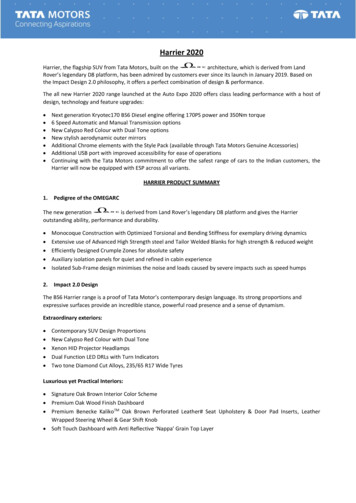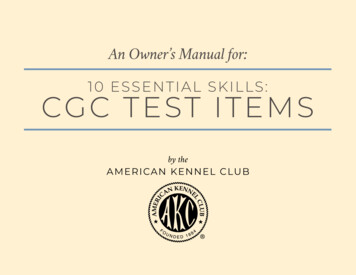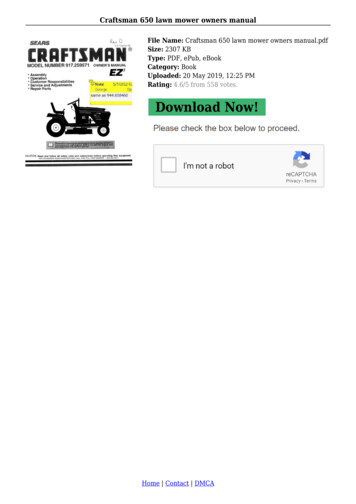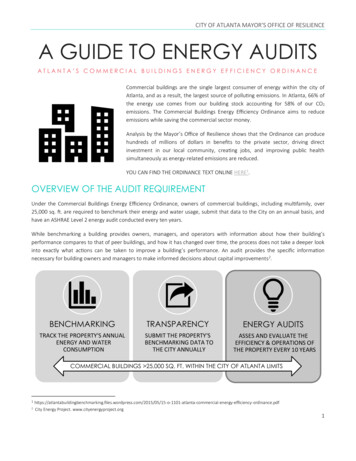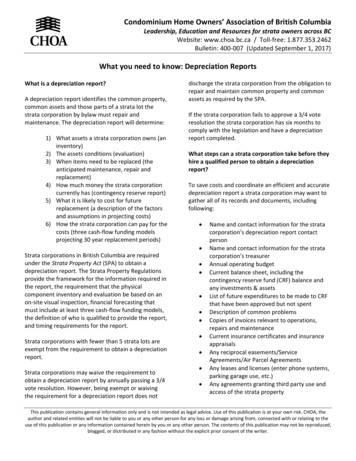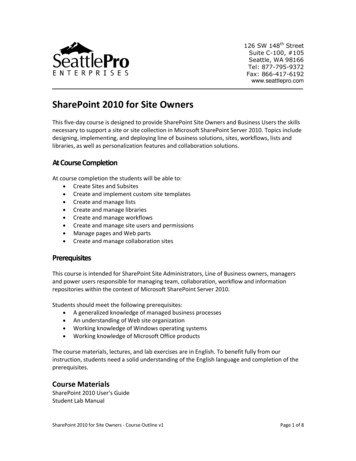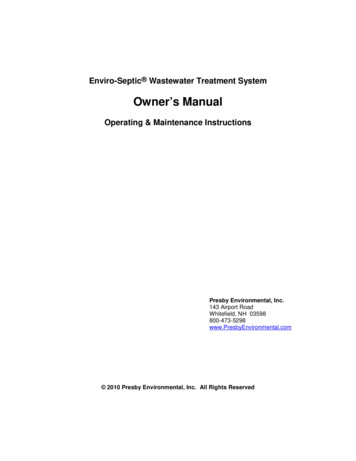
Transcription
Enviro-Septic Wastewater Treatment SystemOwner’s ManualOperating & Maintenance InstructionsPresby Environmental, Inc.143 Airport RoadWhitefield, NH 03598800-473-5298www.PresbyEnvironmental.com 2010 Presby Environmental, Inc. All Rights Reserved
Enviro-Septic U.S. Patent Nos. 6,461,078; 5,954,451; 6,290,429;6,899,359; 6,792,977; 7,270,532 and 5,606,786 with other patents pending.Enviro-Septic is a registered trademark of Presby Environmental, Inc. 2010 Presby Environmental, Inc., All Rights Reserved
PRESBY ENVIRONMENTAL, INC.The Next Generation of Wastewater Treatment Technology143 Airport Rd., Whitefield, NH 03598Tel: 1-800-473-5298Fax: (603) 837-9864www.PresbyEnvironmental.com info@presbyeco.comDear System Owner:Congratulations! You made a wise investment and an environmentally-responsible decision by selectinga state-of-the-art Enviro-Septic Onsite Wastewater Treatment System. The Enviro-Septic Systemrequires virtually no maintenance on the part of the homeowner; however, a basic understanding of howseptic systems function and what is needed to keep them in good working order will help protect yourinvestment, your health and your environment. While the Enviro-Septic system is more tolerant of“abuse” than most, using reasonable care will ensure the longevity and trouble-free operation of yoursystem. The Enviro-Septic System creates an ecosystem that is highly effective at purifying wastewater;the living organisms that perform these natural processes need to be provided with the right environmentin order to survive and carry out their work.This manual will familiarize you with simple steps to maximize the functioning of your system and preventproblems, as well as providing instructions for routine maintenance, troubleshooting and repair. An onsitewastewater treatment system is a significant financial investment, and addressing any problems as soonas they are detected is essential to minimizing the extent of repair that may be required. Wastewatertreatment systems that are improperly designed, installed, used or not maintained can malfunction,sometimes necessitating replacement of the entire system.Having accurate records will greatly assist your service provider in maintaining and evaluating yoursystem. We encourage you to utilize the System Information and Maintenance Record section (found inthe back of this manual) to record important information about your system and its maintenance historyfor ease of future reference.If you ever have questions or need technical assistance of any kind, please contact us by phone at (800)473-5298, by email to info@presbyeco.com, or via our website at www.PresbyEnvironmental.com.Sincerely,David W. PresbyDavid W. PresbyPresident, Presby Environmental, Inc.Inventor, Enviro-Septic System
TABLE OF CONTENTSIntroduction to Wastewater Treatment Process .1The Enviro-Septic System . 2Care and Maintenance . . 4Proper Use of Onsite Septic Systems . . .6Causes & Indicators of System Malfunction . . .11Rejuvenation, Replacement & Expansion . . .13Appendix A, System Information & Maintenance Records . .14
Introduction to the Wastewater Treatment ProcessWhat is the Enviro-Septic Wastewater Treatment System?Enviro-Septic is a passive, non-mechanical wastewater treatment system designed to process, purifyand disperse wastewater in locations not served by a public sewer system. It requires no electricity, nomechanical devices, and no special maintenance. Enviro-Septic has been vigorously tested and provento remove approximately 99% of the contaminants from wastewater that has received primary treatmentin a septic tank. No other passive system provides treatment this effective, and neither do most expensivemechanical devices. An Enviro-Septic Wastewater Treatment System provides superior environmentalprotection and long-term, reliable service at a price that makes it exceptionally cost-effective for theconsumer.What happens in the septic tank?When greywater (from sinks, showers and washing machines) and blackwater (from toilets) exits thestructure, this wastewater flows into a septic tank. The septic tank is a watertight container usually madeof concrete, fiberglass or polyethylene and buried so the top of the tank is below the surface of theground; sometimes a riser is installed to facilitate access to the tank. The wastewater is held in the septictank long enough for solids to settle to the bottom of the tank (forming the “sludge layer”) and for grease,oil and foam to rise to the surface (forming the “scum layer”). The clarified water in between the sludgeand the scum layers exits the septic tank and travels through a tee or baffle into the Enviro-Septic pipes.What happens in the Enviro-Septic System?The patented design of the pipe creates the ideal conditions for further separation of grease and solids(which are retained inside the pipe) and further purification of the wastewater by bacterial action as itpasses through the geotextile fabric and the aerobic “biomat” that forms on it. The biomat is a layer ofbacteria that operates like a living filter, digesting waste materials as the wastewater passes through.The treated wastewater next passes through a layer of System Sand and then into the soil, safelyrecharging groundwater.How is the Enviro-Septic System different from a pipe and stone leaching system?A conventional pipe and stone leaching system is a method of “dispersing” wastewater rather than atreatment system. The biomat in a pipe and stone system eventually becomes dominated by “anaerobic”bacteria (bacteria that exist without oxygen) which forms a thick, slimy biomat, while in the Enviro-Septic System, the biomat maintains a healthy population of “aerobic” bacteria (bacteria that require oxygen),which are considerably more efficient at digesting waste materials. A pipe and stone system relies on thesoil to purify wastewater, while the wastewater which exits an Enviro-Septic System has already beenpurified to a high degree before it reaches the soil. A pipe and stone leaching system would requirealmost three times as much area to handle the same amount of wastewater flow. Conventional systemsare also more prone to failure because the solids in the wastewater (grease and oils, in particular)eventually coat the soil’s surface, preventing the wastewater from infiltrating into the ground. Outdatedtechnologies like pipe and stone systems are big, expensive to build, and they pose a greater threat ofgroundwater contamination.What happens in the soil?The treated wastewater passes through the System Sand and slowly infiltrates into the soil. The EnviroSeptic treatment field may be located underground or constructed as an above-ground mounddepending on the site’s soil conditions and topography. Microbes contained in the soil provide finalpurification of the wastewater, removing bacteria, viruses and nutrients, as the treated wastewaterpercolates through the soil and eventually returns to the groundwater. Since the Enviro-Septic Wastewater Treatment System releases much cleaner water than conventional systems, it can be placedcloser to the groundwater than other systems in many states.
The Enviro-Septic SystemWhat is the Enviro-Septic System and how does it work?The Enviro-Septic Wastewater Treatment System consists of a 12” diameter, high-density plastic pipewhich is corrugated and perforated with skimmer tabs protruding inwardly. A mat of coarse plastic fiberssurrounds the outside of the pipe, and a geo-textile fabric holds the fibers in place, creating a protectedsurface that is optimal for the bacterial processes that purify the wastewater. Wastewater is eitherpumped or travels by gravity into the Enviro-Septic System, where the patented Enviro-Septic pipecools the liquid, separating and retaining the remaining solids and grease inside the pipes, while allowingthe treated wastewater to pass through the pipes and into the fibers and fabric. This provides optimalconditions for the aerobic bacterial activity that result in purification. The Enviro-Septic pipes aresurrounded by a bed of System Sand, which facilitates the process by wicking the liquid out of the pipesand ensuring that the system receives sufficient oxygen to support a healthy population of bacteria.Advantages of an Enviro-Septic Wastewater Treatment System: Cost-effective compared to conventional systems and mechanical devicesRequires no electricity or mechanical partsNeeds no maintenance other than pumping septic tankRequires a smaller treatment fieldBlends into sloping terrainAdapts to difficult site constraintsInstalls more easily and quickly than conventional systemsEliminates the need for expensive washed stoneAdapts easily to both commercial and residential sitesUses a protected receiving surface to maximize bacterial activitySuperior system performance and longevityEnvironmentally safer than conventional systems (confirmed by scientific testing)Recharges groundwater more safely than conventional systemsSignificant post-consumer recycled plastic content2
Cross-Section of Enviro-Septic Pipe:TOP SOIL6 GEO-TEXTILE FABRIC5 COARSE FIBERSSEWN SEAM3 SKIMMERS97 8AIR SPACE2SCUM1WASTEWATER24 RIDGESSLUDGECORRUGATED PLASTIC PIPEWITH EXTERIOR RIDGESSANDORIGINAL SOILStage123456789Summary of Enviro-Septic System ProcessesWarm wastewater enters the pipe and is cooled to ground temperature.Suspended solids separate from the cooled liquid wastewater.Skimmers further capture grease and suspended solids from thewastewater as it exits through perforations in the pipe.Pipe ridges allow the wastewater to flow uninterrupted around thecircumference of the pipe and aid in cooling.A mat of random, coarse fibers separates more suspended solids from thewastewater.Wastewater passes into the geo-textile fabric and grows a protectedbacterial surface.Sand wicks the liquid from the geo-textile fabric and enables air to transferto the bacterial surface.Fabric and fibers provide a large bacterial surface to break down solids.An ample air supply and fluctuating liquid levels increase bacterialefficiency.3
Care and MaintenanceNote: These recommendations are applicable to nearly all onsite septic systems. The EnviroSeptic System requires virtually no maintenance on the part of the system owner. However,reasonable use and care will enhance the longevity and trouble-free operation of your system.Gutter, Drainage and Irrigation Systems:Roof drains, foundation drains, French drains, gutter systems, sump pumps, irrigation systems, etc.should NOT discharge on or near your Enviro-Septic System. Such additional hydraulic loading couldoverload the system and cause it to malfunction. The water from such systems does not requiretreatment and can be safely dispersed away from your treatment system; consult with your designer orinstaller for more information.Perimeter Drains:Perimeter drains are used to lower the groundwater under and around the system location (if necessaryand if allowed per state/local regulations). They surround the system on all four sides and are designedto intercept water and transport it away from the system before being dispersed. If your system includesa perimeter drain, it is very important that you periodically check the outlet to ensure that it remainsunobstructed. It is also a good idea to install “animal guards” (a screen covering the outlet) to preventanimal activity.Grading, Swales and Surface Diversions:After installation, you will probably notice that the soil above the treatment field is slightly “crowned;” thisis done purposely to direct surface water flows away from the system. You may also notice a “swale,”which is a shallow trench in the soil upslope of the treatment field. Crowning and swales are used tointercept surface water flows and direct them away from the treatment field. It is important to the properfunctioning of your system that you do not alter these surface diversions, since they protect the systemfrom being flooded.Venting:An adequate supply of oxygen throughout the Enviro-Septic System is essential to proper functioning.Do not alter or remove any vent stacks. If you are displeased with the appearance of vent stacks, consultwith your installer about “remote venting” or vent disguises.Periodic Pumping of the Septic Tank:One of the advantages of the Enviro-Septic System is that it requires virtually no maintenance other thanthe need to remove the accumulated matter from the septic tank. The majority of the solids in wastewaterare retained in the septic tank, where they settle into the “sludge” layer or float on the surface as the“scum” layer. The bacterial action within the septic tank will break down some of the solids in the tank;the solid waste that isn’t digested accumulates over time as these sludge and scum layers, whicheventually need to be removed. Pumping is required approximately every 3 to 5 years for a typicalresidence with a properly sized system. If a garbage disposal is used, more frequent pumping will berequired.There are many factors which determine how often a particular system’s septic tank needs to be emptied,including: The number of occupants;The amount of wastewater generated;The volume of solids in the waste;The size of the septic tank.4
Refer to the Proper Use section for useful information about how to conserve water and minimize theaccumulation of solids in your septic tank. As a general rule, the septic tank should be pumped when thesurface scum and bottom sludge occupy one-fourth or more of the septic tank’s liquid depth.Selecting a Service Provider:When selecting an individual or a company to pump your tank and inspect your system, make sure thatthey are familiar with Enviro-Septic Systems. Your designer and/or installer may be a good resource forproviding referrals to a reputable local service provider.Routine Inspection and Pumping Frequency:Since it is difficult to predict with precision how often a particular system’s tank will require pumping,Presby Environmental, Inc., recommends that a service professional inspect the system at least onceevery two years, even if there are no indications of a problem, in order to access the need for tankpumping and to confirm that the system’s components are in good working order. There would be no“downside” to emptying the tank every two years, even if the accumulated solids have not reached onefourth of the tank’s liquid depth. Enviro-Septic Systems equipped with a pump or effluent filter willrequire more frequent maintenance (refer to and follow the manufacturer’s recommendations). Septictanks contain toxic gases and only a trained professional with proper gear should attempt to service aseptic tank.Use of Additives:There are a variety of additives on the market which claim to breakdown sludge or boost the bacteriapopulation so that the septic tank will need to be pumped less frequently. These claims are largelyunsupported, and therefore Presby Environmental does not recommend the use of additives of any kind.The microbes needed for effective treatment are naturally present in wastewater; there is no need to useany chemicals, enzymes, yeast, cleaners, solvents or other additives with an Enviro-Septic System.Some of these “treatments” can actually have a detrimental effect on the system, and some states haveeven banned their use.Routine Inspection of System:At the same time that the need for pumping the tank is assessed, the service provider will typicallyperform a routine inspection. Make sure that your service provider is familiar with Enviro-Septic Systems; our systems work differently than conventional systems, so it is important that your serviceprovider knows what is “normal” for our system.-Evaluate the Integrity of the Septic Tank and its Components: (connecting pipes; inlet and outletbaffles; lids, seals and risers; distribution box; filters; pumps; etc.): It is especially important that yourservice provider confirms the structural integrity of the septic tank; if the tank and its seals are notwatertight, water can leak both in and out of it. Water from the environment leaking into the septic tankoverloads the system beyond its treatment capabilities, while untreated wastewater leaking out of theseptic tank poses a health hazard and can contaminate the groundwater. If your system includes adistribution box, the service provider should inspect it to make sure that it has remained level, that itsequalizers are in place (if included in the design), and that it has not become clogged.-Inspect Vents: If the system is vented, the service provider should also verify that the vents are in placeand free of obstructions, since the flow of air to the Enviro-Septic System is crucial to its functioning. A“draw test” may be conducted to confirm that vents are functioning properly. If your system is vented, DONOT remove the vent, as this will diminish the oxygen supply to the Enviro-Septic System, which couldresult in system malfunction. Consult with your designer or installer, or visit our website, for somesuggested ways to relocate or “disguise” unsightly vents.NOTE: Refer to the back of this manual for a System Information and Maintenance section, where youcan keep a record of your system’s maintenance history.5
Proper Use of Onsite Septic SystemsImportance of Water Conservation:Onsite systems are designed based on “daily design flow”, which is usually calculated based on thenumber of bedrooms for residential systems. Note that the daily design flow (in gallons per day) is two orthree times greater than the “actual” amount of wastewater that is expected to be generated by thestructure on a daily basis. Therefore, be aware of situations (additional occupants, addition of fixtures,etc.) which result in an increase of water usage, since this will require more frequent septic tank pumpingand may even necessitate expanding (increasing the size of) the system. If the amount of wastewaterentering is more than the system can handle, wastewater can back up into the house or the yard, creatinga health hazard and a nuisance. The Enviro-Septic System’s ability to be expanded to accommodateincreased daily flow if necessary is one of the product’s many advantages. The use of the toilet,shower/bath and washing machine account for the majority of water use in a typical household.In general, the less wastewater that goes down the drain, the better any onsite system will work. Acommon sense approach to water consumption will maximize your system’s effectiveness. A fewsuggestions for ways to conserve water consumption: Don’t wash all your laundry on the same day, since this will “flash flood” the system andagitate the settled solids. A single load of wash in a typical machine can use up to 62gallons of water. If the system is flash flooded, liquid will pass through more quickly than itis intended to, resulting in incomplete treatment. Instead, distribute the wash loadsthroughout the week. Run your washing machine and dishwasher only when they have full loads. Careful selection of appliances and fixtures that use less water is another way to minimizethe demands placed on your Enviro-Septic System. Look for the terms “Energy Star” or“high-efficiency” in the product’s description. For example, an “Energy Star” washingmachine uses one-half as much water as a traditional model. When you consider that 25-30% of total household wastewater is attributable to toilet use,it is easy to see that replacing a traditional toilet (5-7 gallons per flush) with a highefficiency toilet (1.6 gallons per flush) can conserve a considerable amount of water. Installing aeration devices on faucets and showerheads greatly reduces the amount ofwater used. A “low flow” showerhead reduces the water used in a ten minute shower from50 gallons to 25 gallons. Multiply this by the number of showers per day, and the waterconservation is significant. Leaks and drips within the plumbing system can waste a significant amount of water andshould be repaired immediately. One toilet leaking at a rate of one gallon per minute couldneedlessly send over 1,400 gallons of water per day into your wastewater treatmentsystem.TIP: An excellent resource for learning more about water conservation is available from the EPA atwww.epa.gov/owm/water-efficiency/index.htm6
What not to flush:As described above, how often your septic tank needs to be pumped is dependant on the amount ofsolids that are accumulating in the tank; in addition, certain items if flushed down the toilet can lead toblockages in the pipes or in components of the wastewater treatment system. The following should bedisposed of in the trash rather than by flushing down the toilet: DiapersBaby, hand or cleaning wipes (even if they state “flushable” or “septic safe”)Cat LitterCigarette butts and ashesPlastic or cellophane wrappersChewing gumCoffee grounds or eggshellsFeminine hygiene productsExcessive amounts of toilet paperNapkins, tissues, paper towelsCotton swabs or cotton ballsDental flossCondoms, rubber gloves or other plastic or latex itemsAdhesive bandagesLaundry lintHairNOTE: If it is not biodegradable, it does not belong in your wastewater treatment system!Use of Garbage Disposals:The use of a garbage disposal (also called a “garbage grinder”) creates a tremendous increase in theamount of solids in wastewater, resulting in the need for more frequent pumping (one to two years soonerthan if no garbage disposal is used). While some of the kitchen waste from a garbage disposal will bebroken down by bacterial action, most of it will eventually have to be pumped out.Considerations regarding Hot Tubs:Hot tubs use a tremendous amount of water; if your plumbing system includes a jetted tub larger than 125gallons, the system should be increased in size to accommodate this additional flow. If the hot tub drainsinto the system, the sudden influx of water stirs up the solids in the septic tank and could push them intothe Enviro-Septic System. In addition, the chemical additives sometimes used to disinfect the water inhot tubs are detrimental to the helpful bacteria that are essential to the treatment process. The waterfrom a hot tub does not require treatment, so it is recommended that hot tub water be cooled and thendispersed in an area that is not near the septic tank or treatment field.Water Softeners and Water Purifiers:Water purification systems and water softeners use hundreds of gallons of water. If these appliancesdischarge into the septic tank, it will cause agitation of solids and excess flow to the system. Check withyour plumber about alternative ways to disperse these discharges. The “brine” which exits the waterpurification contains calcium, magnesium and salt; there are differing opinions regarding whether or notthe concentrations of these minerals in the backwash has a negative effect on bacterial function or thehydraulic conductivity of the soil. Since this “backwash” does not require treatment, there is no sense inoverburdening your wastewater treatment system with it.7
Special Considerations for Pumped Systems:Pressure distribution is not to be used with the Enviro-Septic System; however, in some situationssystems may require a pump to gain elevation if the site’s topography does not allow for a gravity system.We recommend that the pump dosing frequency be set so the system is dosed a minimum of 4 times aday. If it is dosed less frequently, an increased volume of wastewater will be sent to the system, whichcould disrupt the settling of solids and greases and lead to clogging.Other substances detrimental to wastewater treatment systems:An Enviro-Septic System is a living collection of organisms, and the introduction of toxins and chemicalscan kill the bacteria that are essential to the treatment process. If it is impossible to avoid the use of anyof the following substances, use care to introduce them a little at a time so their concentration is dilutedand the system can neutralize them gradually.Cleaning Products: The system’s bacteria should recover quickly after small amounts of householdcleaning products enter the system, but using excessive amounts of such substances constitutes systemabuse.Especially Harmful to Bacteria, Use Only in Moderation: bleachchlorineammoniaanti-bacterial soapsdisinfectantsMedications: Some people dispose of medications by flushing them down the toilet. Certainmedications, particularly antibiotics, can have adverse effects on the system’s bacteria. Dispose ofmedications in the trash and not in your plumbing system.Chemicals and Toxic Substances: The following substances are harmful to the living organisms in yoursystem and introducing them constitutes system abuse. These substances can not only have an adverseeffect on your system, they can also result in groundwater contamination. Check with your localsanitation department for proper disposal procedures for: FertilizersRoot killers or other products with copper sulfatePoisons or pesticidesDrain cleanersOven cleaners or other lye-based productsDegreasersPhotographic processing chemicalsPetroleum products of any kindLatex paint, oil paint, stains, thinners and solventsAntifreezeChlorinated water from swimming pools or hot tubsGrease and Cooking Oil: Grease may harden in the septic tank’s scum layer and result in a blockage ofthe inlet or outlet. If you melt grease and pour it down the drain, it may make its way into the systembefore hardening, which could clog the fibers and fabrics in the Enviro-Septic pipe and/or the pores ofthe soil in the treatment field. Whenever possible, it is preferable to dispose of waste grease and oil in thetrash rather than down the drain.8
Care of System During Periods of Intermittent or Non-use:The Enviro-Septic System does not require any special maintenance before, during or after periods ofnon-use. While the system’s bacteria may go temporarily dormant if the system is not used for awhile,once wastewater re-enters the system it will return to its normal function in a short period of time. It wouldnot be advisable to have the septic tank pumped and left unused at times when the groundwater is high,as this could cause the tank to “float” out of the ground.Proper Care of the Treatment Field:General Comments: Do not build anything above the treatment fieldDo not drive over the treatment field (unless the system was designed for this)Do not dig in the treatment fieldDo not plant trees or shrubs in the treatment fieldDo not store heavy equipment or park on the treatment fieldDo not install irrigation systems in the treatment fieldDo not allow any gutter or drainage systems to discharge above the treatment fieldDo not install additional soil cover materials over the treatment fieldLandscaping and Planting in the Treatment Field: Do not plant trees or shrubs within 10’ of the treatment field, since there is the potential forroots to damage the components and interfere with the system’s functioning.After installation and proper grading to divert surface waters, the treatment field should bemulched and seeded promptly in order to prevent erosion.Only shallow rooted, native vegetation should be planted above the treatment field. Grass,wildflowers and shallow-rooted groundcovers are good choices.Vegetative cover over the treatment field is important because it contributes to theelimination of nitrogen and phosphorous.Do not use fertilizers in the area above the treatment field.Do not plant gardens for human consumption above the treatment field.Take care not to compact the soil when landscaping; compacted soil above the system canreduce the oxygen supply and gas transfer.Ventilation: Vents are recommended for Enviro-Septic Systems to ensure that the system receives asufficient supply of oxygen, which is required for the bacterial processes that treat thewastewater. Whether or not vents are required varies from state-to-state. Vents can beadded later if not called for in the original design. Typically, vents will look like a cane-shaped piece of PVC protruding straight up out of theground or mound in the treatment field. Vents should be checked periodically to ensure that they are not clogged or blocked in anyway, for instance by leaves, animal activity or snow accumulation. Do not under any circumstances remove the vent or cover it with any materials that willimpede the flow of oxygen. The vent inlet should be a minimum of 3 ft. higher than finalgrade or above the yearly expected height of snow accumulation.9
If you are concerned about the unsightly appearance of vents, consult with your installerabout the possibility of installing remote or by-pass venting in order to locate vents in aless-conspicuous area away from the treatment field. This information is also available onour website, www.presbyenvironmental.com. Unsightly vents can also be disguised by installing specially-designed products whichconceal the vent but still allow sufficient oxygen flow. These products, constructed ofdurable but lightweight plastic, are made to look like a large rock, a granite post, a birdbath,etc. If you are interested in purchasing a vent disguise, contact your installer or call PresbyEnvironmental and we can refer you to a distributor near you. Some customers find that simply painting the vent stack (green, brown, camouflage, etc.)makes it much less noticeable. Resist the temptation to conceal vents with landscaping; no trees or shrubs may be locatedwithin 10 feet of the treatment field to prevent the infiltration of roots.10
Causes & Indicators of Septic System MalfunctionWhat is “System Malfunction”?The term “system malfunction” refers to any situation in which a septic system has stopped operating asexpected. One of the unique advantages
The Enviro-Septic System requires virtually no maintenance on the part of the homeowner; however, a basic understanding of how septic systems function and what is needed to keep them in good working order will help protect your investment, your health and your environment. While the Enviro-Septic system is more tolerant of
